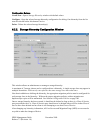users do frequent appends, or if those who do can be relied upon to turn truncation off for their own
files, or if the system administrator can easily identify files which are frequently appended and can
turn off truncation on them individually, then the site might want to take advantage of the space
savings for the remaining files and leave Truncate Final Segment on in the COS definition.
One additional consideration is that truncating the final segment incurs a small performance penalty.
In development testing, this penalty was measured at 14% for writing 100 files with truncation in
comparison to writing them without truncation; this value may vary under different site
configurations.
Class Characteristics
• Access Frequency. The frequency, on average, for accessing files in this COS. Valid values are
Hourly, Daily, Weekly, Monthly or Archive.
• Optimum Access Size. The suggested number of bytes that should be written at one time for
maximum efficiency. (Not currently used by HPSS. May be used by site specific applications)
• Average Latency. The average time, in seconds, that elapses between the time a transfer request is
accepted for processing and the time the data transfer begins.
• Transfer Rate. The average throughput (in KB per second) that can be transferred using this COS.
R/W Operations
• Read. If ON, files in this COS are readable, subject to the permissions on each individual file.
• Write. If ON, files in this COS are writable, subject to the permissions on each individual file.
• Append. If ON, files in this COS can have new data appended to them, subject to the permissions on
each individual file. This button may only be ON if the Write button is also ON. If the Write button
is OFF, the Append button is disabled.
In all cases, whether an individual file can be read or written will be determined by the permissions
on that particular file. It may be the case that a COS is RW, but certain files within that COS may
have their permissions set such that they can be neither read nor written.
6.3.3. Changing a Class of Service Definition
A COS definition can be changed by bringing up the Class of Service Configuration window and making
the desired modifications. Fields on the Class of Service Configuration window that can be changed
without major impact are the Access Frequency, Optimum Access Size, Average Latency, and Transfer
Rate. These fields are advisory in nature and are currently used only by the Client API. Users of custom
HPSS interfaces will have to assess the impact of any change.
The Maximum File Size can be changed, but care should be exercised when doing so. Increasing this
value may result in storing files that are inappropriate for the hierarchy supporting this COS. For
example, suppose a hierarchy is defined with disk at the top level with a storage segment size of 64 KB
and the Maximum File Size in this COS is set to 1 MB. Changing the maximum file size to 2 GB in this
class would be inappropriate because 32768 64KB storage segments would be needed to contain such a
file.
Associated with the Maximum File Size is the Enforce Maximum File Size flag. Changing this can
HPSS Management Guide November 2009
Release 7.3 (Revision 1.0) 178


















